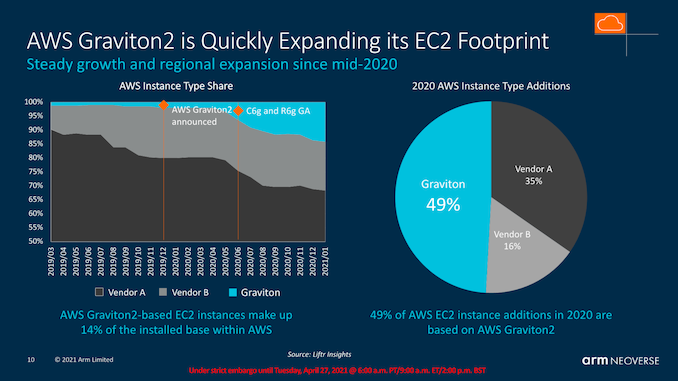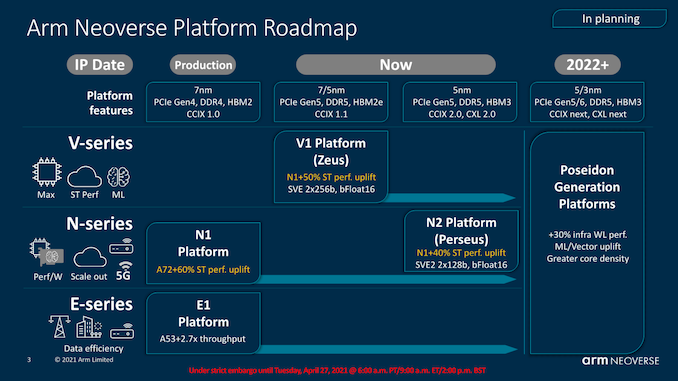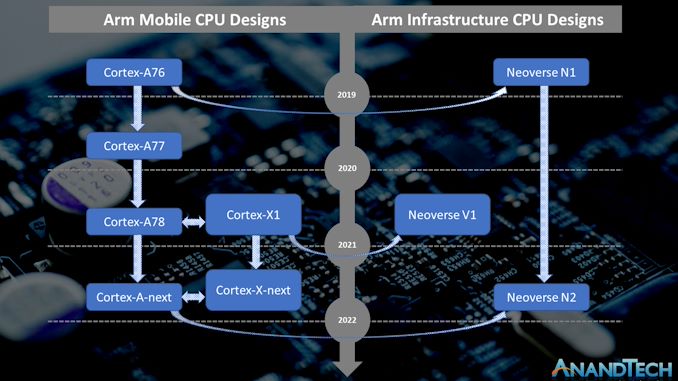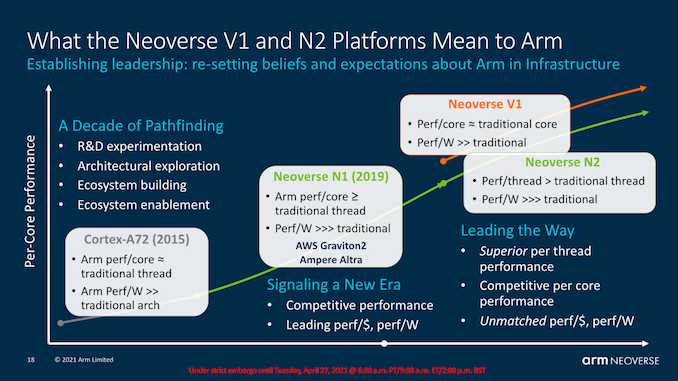Arm Announces Neoverse V1, N2 Platforms & CPUs, CMN-700 Mesh: More Performance, More Cores, More Flexibility
by Andrei Frumusanu on April 27, 2021 9:00 AM EST- Posted in
- CPUs
- Arm
- Servers
- Infrastructure
- Neoverse N1
- Neoverse V1
- Neoverse N2
- CMN-700

2020 has been an extremely successful year for Arm’s infrastructure and enterprise endeavours, as it was the year where we’ve seen fruition of the company’s “Neoverse” line of CPU microarchitectures hit the market in the form of Amazon’s new Graviton2 design as well as Ampere’s Altra server processor. Arm had first introduced the Neoverse N1 back in early 2019 and if you weren’t convinced of the Arm server promise with the Graviton2, the more powerful and super-sized Altra certainly should have turned some heads.
Inarguably the first generation of Arm servers that are truly competitive at the top end of performance, Arm is now finally achieving a goal the company has had in their sights for several years now, gaining real market share against the x86 incumbents.
Fast-forward to 2021, the Neoverse N1 design today employed in designs such as the Ampere Altra is still competitive, or beating the newest generation AMD or Intel designs – a situation that which a few years ago seemed farfetched. We recommend catching up on these important review pieces over the last 2 years to get an accurate picture of today’s market:
- Arm Announces Neoverse N1 & E1 Platforms & CPUs: Enabling A Huge Jump In Infrastructure Performance
- Amazon's Arm-based Graviton2 Against AMD and Intel: Comparing Cloud Compute
- The Ampere Altra Review: 2x 80 Cores Arm Server Performance Monster
- AMD 3rd Gen EPYC Milan Review: A Peak vs Per Core Performance Balance
- Intel 3rd Gen Xeon Scalable (Ice Lake SP) Review: Generationally Big, Competitively Small

(Note: Y axis left chart starts at 50%)
Arm is very open that their main priority with the Neoverse line of products is gaining cloud footprint deployment market share, and as an example of the new-found success is an estimate into Amazon’s own AWS instance additions throughout 2020, where the new Arm-based Graviton2 is said to be the dominant hardware deployment, picking up the majority of share that’s being lost by Intel.
Looking towards 2022 and Beyond
Today, we’re pivoting towards the future and the new Neoverse V1 and Neoverse N2 generation of products. Arm had already tested the new products last September, teasing a few characteristics of the new designs, but falling short of disclosing more concrete details about the new microarchitectures. Following last month’s announcement of the Armv9 architecture, we’re now finally ready to dive into the two new CPU microarchitectures as well as the new CMN-700 mesh network.
As presented back in September, this generation of Neoverse CPU microarchitectures differ themselves in that we’re talking about two quite different products, aimed at different goals and market segments. The Neoverse V1 represents a new line-up for Arm, with a CPU microarchitecture that is aiming itself for more HPC-like workloads and designs oriented towards such markets, while the Neoverse N2 is more of a straight-up successor to the Neoverse N1 and infrastructure and cloud deployments in the same way that the N1 sees itself today in products such as the Graviton or Altra processors.
For readers who are familiar with Arm’s mobile CPU microarchitectures, there’s definitely very large similarities between the designs – even though Arm’s marketing seems to be oddly reluctant to make such kind of comparisons, which is why I made the above chart which more clearly tries to depict the similarities between design generations.
The original Neoverse N1 as seen in the Graviton2 and Altra Q processors had been a derivative, or better said, a sibling microarchitecture, to the Cortex-A76, which had been employed in the 2019 generation of Cortex-A76 mobile SoCs such as the Snapdragon 855. Naturally, the Neoverse designs had server-oriented features and changes that aren’t present in the mobile counterparts.
Similarly to how the N1 was related to the A76, the new generation V1 and N2 microarchitectures are related to newer designs in the Cortex-portfolio. The V1 is related to the Cortex-X1 which we’ve seen in this year’s new mobile SoCs such as the Snapdragon 888 or Exynos 2100. The Neoverse N2 on the other hand is related to an upcoming new Cortex-A microarchitecture which we expect to hear more about in the following few months. Throughout the piece today we’ll make a few more references to this generational disconnect between the V1 and N2, and it’s important to remember that the N2 is a newer design, albeit aimed at different performance and efficiency points.
This decoupling of design goals between the V1 and N2 for Arm comes through the company’s attempt to target more specific markets where the end products might have different priorities, much like how in the mobile space the new Cortex-X series prioritises per-core performance while the Cortex-A series continues to focus on the best PPA. Similarly, the V1 focuses on maximised performance at lower efficiency, with features such as wider SIMD units (2x256b SVE), while the N2 continues the scale-out philosophy of having the best power-efficiency while still moving forward performance through generational IPC improvements.
In today’s piece, we’ll be diving into the new microarchitectural changes of the V1, N2, as well as Arm’s newest generation mesh interconnect IP, the CMN-700, which is expected to serve as the foundation of the next-generation Arm infrastructure processors.
Table of contents:
- A Successful 2020 for Arm - Looking Towards 2022
- The Neoverse V1 Microarchitecture: X1 with SVE?
- The Neoverse V1 Microarchitecture: Platform Enhancements
- The Neoverse N2 Microarchitecture: First Armv9 For Enterprise
- The SVE Factor - More Than Just Vector Size
- PPA & ISO Performance Projections
- The CMN-700 Mesh Network - Bigger, More Flexible
- Eventual Design Performance Projections
- First Thoughts & End Remarks













95 Comments
View All Comments
Dug - Tuesday, April 27, 2021 - link
Now is when I wish ARM was publicly traded.mode_13h - Tuesday, April 27, 2021 - link
Well, you could buy NVDA, under the assumption the acquisition will go through.dotjaz - Thursday, April 29, 2021 - link
SoftBank is already publicly traded on the Tokyo Stock Exchange. Why rely on NVIDIA buyout which for all likelihood won't happen any time soon if at all.mode_13h - Thursday, April 29, 2021 - link
> SoftBank is already publicly traded on the Tokyo Stock Exchange.They also invested heavily in WeWork, when it was highly over-valued. I have no idea what other nutty positions they might've taken, but I think it's not a great proxy for ARM just due to its sheer size.
cjcoats - Tuesday, April 27, 2021 - link
As an environmental modeling (HPCC) developer: what is the chance of putting a V1 machine on my desk in the foreseeable future?Silver5urfer - Tuesday, April 27, 2021 - link
Never. Since there has to be an OEM for these chips to put in DIY and Consumer machines, so far except the HPE's A64FX ARM there's no way any consumer can buy these ARM processors and that is also highly expensive over 5 digit figure. And then the drivers / sw ecosystem comes into play, there's passion projects like Pi as we all know but they are nowhere near the Desktop class performance.ARM Graviton 2 was made because AWS wants to save money on their Infrastructure, that's why their Annapurna design team is working there. Simply because of that reason Amazon put more effort onto it AND the fact that ARM is custom helps them to tailor it to their workloads and spread their cost.
Altra is niche, Marvell is nowhere near as their plans was to make custom chips on order. And from the coverage above we see India, Korea, EU use custom design licensing for their HPC Supercomputer designs.
Then there's a rumor that MS is also making their own chips, again custom tailored for their Azure, Google also rumored esp their Whitechapel mobile processor (it won't beat any processor on the market that's my guess) and maybe their GCP oriented own design.
These numbers projection do look good vs x86 SMT machines finally to me after all these years, BUT have to see how they will compete once they are out vs 2021 HW is the big question, since if these CPUs outperform the EPYC Milan technically AWS should replace all of them right ? since you have Perf / Power improvements by a massive scale. Idk, gotta see. Then the upcoming AMD Genoa and Sapphire Rapids competition will also show how the landscape will be.
SarahKerrigan - Tuesday, April 27, 2021 - link
If they don't replace all the x86 systems in AWS with ARM, that *must* mean Neoverse is somehow secretly inferior, right??Or, you know, it could mean that x86 compatibility matters for a fair chunk of the EC2 installed base, especially on the Windows Server side (which is not small) but on Linux too (Oracle DB, for instance, which does not yet run on ARM.)
Silver5urfer - Tuesday, April 27, 2021 - link
That was a joke.Spunjji - Friday, April 30, 2021 - link
Was it, though? Schrodinger's Joke strikes again.Raqia - Tuesday, April 27, 2021 - link
Maybe not an V1 but you could probably get a more open high performance ARM core than the Apple MX series pretty soon:https://investor.qualcomm.com/news-events/press-re...
"The first Qualcomm® Snapdragon™ platforms to feature Qualcomm Technologies' new internally designed CPUs are expected to sample in the second half of 2022 and will be designed for high performance ultraportable laptops."